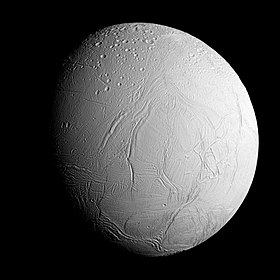Enceladus

View of trailing hemisphere in natural colour, pictured by Cassini
|
|||||||||||||
| Discovery | |||||||||||||
|---|---|---|---|---|---|---|---|---|---|---|---|---|---|
| Discovered by | William Herschel | ||||||||||||
| Discovery date | August 28, 1789 | ||||||||||||
| Designations | |||||||||||||
| Pronunciation | /ɛnˈsɛlədəs/ | ||||||||||||
| Saturn II | |||||||||||||
| Adjectives | Enceladean, Enceladan | ||||||||||||
| Orbital characteristics | |||||||||||||
| 237948 km | |||||||||||||
| Eccentricity | 0.0047 | ||||||||||||
| 1.370218 d | |||||||||||||
| Inclination | 0.019° (to Saturn's equator) | ||||||||||||
| Satellite of | Saturn | ||||||||||||
| Physical characteristics | |||||||||||||
| Dimensions | 513.2 × 502.8 × 496.6 km | ||||||||||||
|
Mean radius
|
252.1±0.2 km (0.0395 Earths, 0.1451 Moons) | ||||||||||||
| Mass | (1.08022±0.00101)×1020 kg (1.8×10−5 Earths) | ||||||||||||
|
Mean density
|
1.609±0.005 g/cm3 | ||||||||||||
| 0.113 m/s2 (0.0113 g) | |||||||||||||
| 0.239 km/s (860.4 km/h) | |||||||||||||
| Synchronous | |||||||||||||
| Zero | |||||||||||||
| Albedo | 1.375±0.008 (geometric at 550 nm) or 0.81±0.04 (Bond) | ||||||||||||
|
|||||||||||||
| 11.7 | |||||||||||||
| Atmosphere | |||||||||||||
|
Surface pressure
|
Trace, significant spatial variability | ||||||||||||
| Composition by volume | 91% water vapor 4% nitrogen 3.2% carbon dioxide 1.7% methane |
||||||||||||
Enceladus (pronounced /ɛnˈsɛlədəs/) en-CELL-ə-dəs; is the sixth-largest moon of Saturn. It is about 500 kilometers (310 mi) in diameter, about a tenth of that of Saturn's largest moon, Titan. Enceladus is mostly covered by fresh, clean ice, making it one of the most reflective bodies of the solar system. Consequently, its surface temperature at noon only reaches −198 °C (−324 °F), far colder than a light-absorbing body would be. Despite its small size, Enceladus has a wide range of surface features, ranging from old, heavily cratered regions to young, tectonically deformed terrains that formed as recently as 100 million years ago.
Enceladus was discovered on August 28, 1789, by William Herschel, but little was known about it until the two Voyager spacecrafts, Voyager 1 and Voyager 2, passed nearby in the early 1980s. In 2005, the Cassini spacecraft started multiple close flybys of Enceladus, revealing its surface and environment in greater detail. In particular, Cassini discovered water-rich plumes venting from the south polar region.Cryovolcanoes near the south pole shoot geyser-like jets of water vapor, molecular hydrogen, other volatiles, and solid material, including sodium chloride crystals and ice particles, into space, totaling about 200 kilograms (440 lb) per second. Over 100 geysers have been identified. Some of the water vapor falls back as "snow"; the rest escapes, and supplies most of the material making up Saturn's E ring. According to NASA scientists, the plumes are similar in composition to comets. In 2014, NASA reported that Cassini found evidence for a large south polar subsurface ocean of liquid water with a thickness of around 10 km (6 mi).
...
Wikipedia
